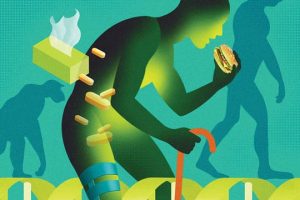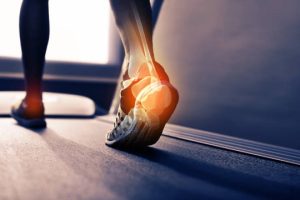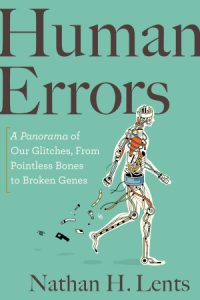WSJ Essay
The Botch of the Human Body: Our many design glitches, from weak knees to poor sinus drainage to infertility, highlight the randomness of evolution
Nathan H. Lents, April 13, 2018
Over the past decade, geneticists and biologists have learned more about our evolution than we ever thought  possible. Not all of it is pretty. For example, the DNA in our cells is littered with huge stretches of repetitive, useless gobbledygook. Our chromosomes also harbor thousands of viral “carcasses,” baggage left by infections that our ancestors fought millions of years ago.
possible. Not all of it is pretty. For example, the DNA in our cells is littered with huge stretches of repetitive, useless gobbledygook. Our chromosomes also harbor thousands of viral “carcasses,” baggage left by infections that our ancestors fought millions of years ago.
Evolution has not perfected our species—far from it. The human body, wondrous and beautiful as it may be, is cluttered with glitches and inefficiencies, the messy byproducts of evolution’s creative process. Natural selection is a blind, groping process, one that frequently produces terrible problems in addition to workable prototypes.
Some of our flaws are due to little more than a mismatch between the world we live in now and the world we evolved in. Our immediate ancestors spent several million years eking out a living on the grassy plains of sub-Saharan Africa, an environment that bears little resemblance to the ones most of us now inhabit. These unfortunates spent hours each day chewing tough roots, choking down leaves and stems, munching on tiny berries and gorging on rare windfalls of meat, bone marrow and worms.
It was during this time that our body’s metabolic system, which determines how we derive energy from food, developed one of its defining features: We are built to pack on the pounds when food is plentiful, and we retain that weight when we are deprived of calories. This system made very good sense back then, but it has backfired now that we graze not on roots and grubs but on a veritable savanna of rich, calorie-packed foods. Because natural selection never rewarded will power, it’s no surprise that we have so little of it now.
This is just one of countless examples of how poorly suited our bodies are to our current environment. We sprain our ankles, twist our knees and suffer debilitating back pain much more than we would have been able to endure in the unforgiving Pleistocene epoch. This is chiefly because we sit in chairs, wrap our feet in supportive shoes and generally construct our surroundings to be as smooth and gentle as possible, leaving our muscles and tendons weak in all the wrong places.
But we can’t blame all of our aches and pains on modern living. A host of other bodily glitches are due to nothing more than the inherent limits of evolution. What sense could it ever have made, for example, to bend our backbones into an S-shape, which leaves us vulnerable to slipped disks, pinched nerves and lower back pain? Why are there seven bones in our ankle and eight in our wrist, like a useless pile of rocks, good for nothing but sprains and strains? And how could our knees have come to hinge on a tiny ligament, the oft-torn anterior cruciate ligament, or ACL?

Our bodies, ankles included, are poorly suited to our environment
All of these questions have a single, simple answer: Evolution does not make or have a plan. Natural selection can only work on the bodies we have, making slight tweaks and tugs through the randomness of mutations.
Human anatomy has other design quirks that defy easy categorization. For instance, adults average three to four head colds a year, and children can suffer 10 or more, whereas other animals—even our fellow apes—don’t seem to be plagued by them at all. The reason is as annoying as the cold symptoms themselves: the drainage point of our largest nasal sinus is placed at the top of the chamber. Because of gravity, this poor arrangement impedes the flow of mucus, and it doesn’t take much to gum up the system.
Hobbled by poor design, humans fall short of our fellow animals in other ways. Many creatures are healthy eating the same two or three foods their whole lives. The koala can do fine eating just one kind of leaf. Humans, on the other hand, have very particular needs for very specific micronutrients. Why? Because we lost the ability to make them for ourselves.
Vitamin C, for example, is an important molecule that the vast majority of animals synthesize in their livers. Not us. One of the key genes for vitamin C synthesis was mutated beyond repair in one of our distant ancestors. If we don’t get vitamin C in our diet, we die of scurvy.
The case of Vitamin B12 is even stranger. We can only extract this important nutrient from animal products like meat and eggs. But the vast majority of herbivore animals do just fine since they conveniently have bacteria in their intestines that make vitamin B12 for them. It turns out that we do too, except that we harbor those bacteria in our large intestine while we can only absorb vitamin B12 in our small intestine. Bad plumbing strikes again.
Even the human reproductive system—which one might expect to be fairly streamlined, given its importance for the continuation of the species—is riddled with errors and inefficiencies, as one of the nearly 10% of us that struggle with infertility can attest. For instance, women’s ovaries aren’t connected to their fallopian tubes, an evolutionary oversight that sometimes leads to eggs
Even when eggs make it into the fallopian tube, it’s a miracle that sperm are able to locate them; sperm cells must travel around 17.5 centimeters to meet the egg, which is a challenge given that this is more than 3,000 times the length of their bodies—and that sperm cells cannot turn left. The corkscrew-like movement of their tails propels them in right-hand circles along a completely random path. Considering the challenges of even fertilizing an egg, never mind the other hurdles that developing fetuses must overcome between conception and childbirth, every baby really is a miracle.
But just because evolution is kind of dumb doesn’t mean that humans are. We are tremendously intelligent and resourceful—the ultimate generalists. Rather than specializing in one habitat, one food source or one survival strategy, we evolved to find success in whatever way we could. Our big brains were the key to this creative approach, but this came with a very big drawback. As we came to rely on ingenuity in solving life’s challenges, this relaxed the pressure on our bodies. We no longer had to be in tiptop shape in order to find a way to survive and thrive. Our error-prone bodies are what happens when the pressure is taken off.
An even bigger drawback may yet be in store. The same ingenuity that allowed humans to hit home runs with evolution’s curveballs has arguably created the risk of environmental destruction, resource exhaustion, anthropogenic climate change and thermonuclear war. This is partly because our brains—powerful as they are—are also full of glitches. We commit cognitive errors in surprisingly predictable patterns and struggle to grasp the mathematics of large numbers, which limits our ability to learn important lessons and make good decisions.
Just like evolution itself, humans fail to prioritize long-term planning even in the face of imminent threat. As a result, many of the dangers our species now faces are purely of our own making. Ironically, the big brain that helped humankind to transcend the limitations of our bodies may turn out to be our biggest flaw.

